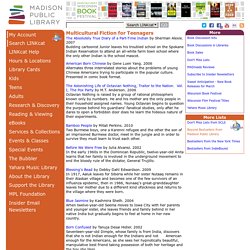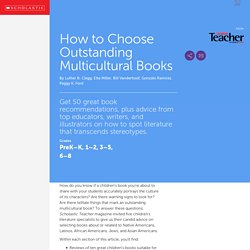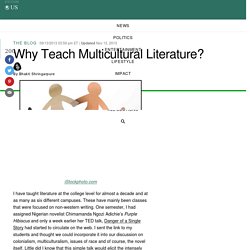

Untitled. Importance of Multicultural Schooling for children - Parent's Take. Educators - Social Justice Resources - Race. Multicultural Literature: High School. Global rating average: 0.0 out of 50.00.00.00.00.0 This site provides recommended book lists, the historical background of multicultural literature, and informational articles about multicultural literature.

Author interviews and book trailers are provided. Grades Links This wiki provides information on teaching multicultural literature: include information on Native American, Chicano, Asian American, and Modern Middle East literature. This article explores the value of teaching multicultural literature in the Reading curriculum. This article explore the importance of using multicultural literature. This article provides leads to 50 great books, tips from authors, illustrators, and educators on how to recognize literature that transcends stereotypes. Multicultural literature allows readers to see the diversity of the world and to inspire discussions about race.
Provide a multicultural reading list to grades nine through twelve students. Naming traditions vary across cultures. Missing Adventures: Diversity and Children's Literature. Multicultural - Best Young Adult Book Lists - Guides Home at Contra Costa County Library. Multicultural Fiction for Teenagers. The Absolutely True Diary of a Part-Time Indian by Sherman Alexie. 2007Budding cartoonist Junior leaves his troubled school on the Spokane Indian Reservation to attend an all-white farm town school where the only other Indian is the school mascot.

American Born Chinese by Gene Luen Yang. 2006Alternates three interrelated stories about the problems of young Chinese Americans trying to participate in the popular culture. Presented in comic book format. The Astonishing Life of Octavian Nothing, Traitor to the Nation. Vol. I, The Pox Party by M.T. Bamboo People by Mitali Perkins. 2010Two Burmese boys, one a Karenni refugee and the other the son of an imprisoned Burmese doctor, meet in the jungle and in order to survive they must learn to trust each other. Before We Were Free by Julia Alvarez. 2002In the early 1960s in the Dominican Republic, twelve-year-old Anita learns that her family is involved in the underground movement to end the bloody rule of the dictator, General Trujillo.
Multicultural literature in the classroom. Seven Ways to Evaluation Multicultural Literature. Multicultural literature. How to Choose the Best Multicultural Books. How do you know if a children's book you're about to share with your students accurately portrays the culture of its characters?

Are there warning signs to look for? Are there telltale things that mark an outstanding multicultural book? To answer these questions, Scholastic Teacher magazine invited five children's literature specialists to give us their candid advice on selecting books about or related to Native Americans, Latinos, African Americans, Jews, and Asian Americans. Within each section of this article, you'll find: Reviews of ten great children's books suitable for grades K–8Essential advice from a children's author or illustrator: Joseph Bruchac, Gary Soto, Floyd Cooper, Patricia Polacco, Yumi HeoKey criteria to use when selecting booksA list of notable authorsAnd more! Our experts also helped us compile an extensive list of other multicultural resources for teachers and their classrooms.
Native Americans: Let Our Words Be Heard. Untitled. Multicultural Literature: Definition, Books & Importance. Why Teach Multicultural Literature? iStockphoto.com I have taught literature at the college level for almost a decade and at as many as six different campuses.

These have mainly been classes that were focused on non-western writing. One semester, I had assigned Nigerian novelist Chimamanda Ngozi Adichie’s Purple Hibiscus and only a week earlier her TED talk, Danger of a Single Story had started to circulate on the web. I sent the link to my students and thought we could incorporate it into our discussion on colonialism, multiculturalism, issues of race and of course, the novel itself. Little did I know that this simple talk would elicit the intensely disproportionate response that landed in my inbox the next morning.
Why teach U.S. students literature from different countries? Here is the video that set this off, followed by the student’s letter and my response: About the Adichie talk at the TED conference. In my opinion, Adichie perfectly typifies what you could call the ugly side of multiculturalism. Change in the “All White World of Children’s Literature”
Resource: Teaching Multicultural Literature: A Workshop for the Middle Grades. Workshop 1: Engagement and Dialogue: Julia Alvarez, James McBride, Lensey Namioka, and more In New York City, Carol O'Donnell and her students explore themes of multiple worlds and dual identities. They read poetry by Diana Chang and Naomi Shihab Nye, the novel The Color of Water by James McBride, essays and short stories by Gish Jen, Khoi Luu, Lensey Namioka, and Julia Alvarez, and a monologue by Tina Lee.
Through a series of innovative drama, role-playing, and writing activities, students examine the social and cultural experiences of the characters, and reflect on their own definitions and experiences of identity. Go to this unit. Workshop 2: Engagement and Dialogue: Judith Ortiz Cofer and Nikki Grimes The workshop begins with a profile of the writer Judith Ortiz Cofer and then moves to Vista, California, where Akiko Morimoto and her students read short stories from Cofer's collection, An Island Like You.
Multilit. Untitled.